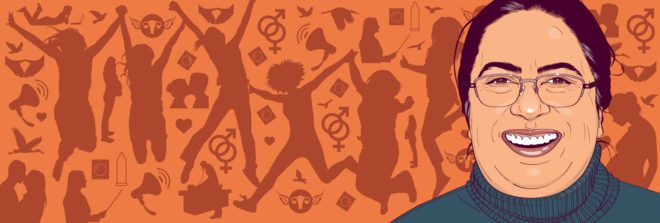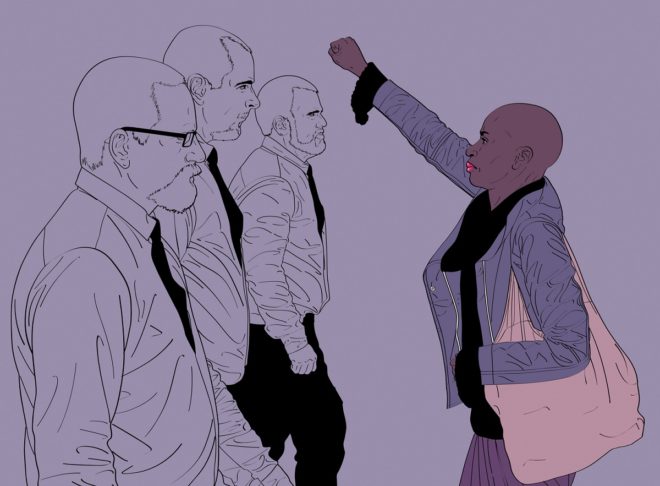Artist at Work: María María Acha-Kutscher, Feminist Visual Artist
In a moment when the world is divided on critical social justice and human rights issues, art can serve as a bridge between the world we live in and the change we seek. Acha-Kutscher’s work gives us something to hold onto as we cross that bridge together.

This is the second part of a new “Artists at Work” series, featuring individuals who are working to shift culture through art. This series is published in collaboration with Echoing Ida, a Forward Together project.
All too often women are written out of history—leading many to believe that most if not all of the people responsible for shaping our society were men. But through her illustrations, María María Acha-Kutscher is ensuring that we do not forget how women have been fighting and confronting racism, rape culture, gender-based violence, and other human rights issues.
A Peruvian artist based in Madrid, Acha-Kutscher is making visible the ways in which women worldwide have fought—and are fighting—to transform the conditions and circumstances of their communities.
Since she began her digital drawings of women activists in 2008, she has profiled more than 200 women—some of whom are unidentified participants in protests around the world such as Occupy Wall Street and Slutwalk, as well as historical figures and current leaders in social movements. Between her popular online images, partnerships with women’s rights organizations, and her commissioned work in public spaces, Acha-Kutchser’s illustrations have reached millions of people worldwide.
It would seem as if Acha-Kutscher was destined to be an artist; she grew up in a family of artists and art enthusiasts, including her grandfather, the late Juan Acha, a renowned contemporary art theorist in Latin America.
After studying graphic design at the Universidad Católica del Perú, Acha-Kutscher worked as an editorial illustrator, graphic designer, and art director for advertising agencies in Mexico for nearly a decade. It wasn’t until she moved to Madrid, in 2001, that she began working full time as an artist. In 2003, she and her husband, Tomás Ruiz-Rivas, started Antimuseo, a curatorial project that analyzes the structure and limitations of arts institutions.
More recently, she profiled 14 women activists fighting for freedom around the world for the #DefendHer campaign. Presented by the Global Fund for Women, Just Associates (JASS) and MADRE, #DefendHer highlights women who risk harassment and violence to ensure that the human rights of their communities are respected and protected.
Acha-Kutscher’s #DefendHer digital drawings have included women like Melania Chiponda, who advocates for women’s rights to land ownership and an end to sexual abuse by security forces in Zimbabwe, and Azra Causevic, a queer and trans activist fighting for a dignified life free of violence for LGBTQIA people in Bosnia and Herzegovina.
Rewire had a chance to interview Acha-Kutscher via email in the fall about her artwork and her contribution to the #DefendHer campaign. Below is a lightly edited transcript of our conversation.
Rewire: What inspired you to be an artist who tackles political content in her work?
María María Acha-Kutscher: The political and social consciousness was always there. I was born in Perú, a place where social inequalities border on injustice, especially for women. When I started to work full time as an artist, I discovered that I could use art as a political tool to demand the improvement of the conditions of women.
Rewire: Is that what you mean by “feminist visual artist” in your bio? What does that phrase mean to you?
MMAK: It means that my artwork has a political dimension and it plays a dual role: It’s an artistic product, and it’s also an instrument that contributes to political transformations, especially for women. My work is recovering women’s history and creating a new women’s imaginary based in modern feminist movements. For example, my series “Indignadas” (Outraged Women), which is part of my project “Women Working for Women,” consists of drawings based off of press photographs of women involved in protest movements. It creates a visual record showing the woman in political action and her body as a support for the political message. By transforming photographs into drawings, I immortalize these actions to show that women and men made social changes throughout history together.
Rewire: You’ve been creating portraits of women activists for years. Why did you start creating those portraits? And how do you choose the women you illustrate?
MMAK: As part of my work I constantly research women’s history in books, magazines, the internet, and the news. When I started to illustrate these women in 2008, there was not much information about them. Nobody, as far I knew, was creating a visual register on feminist, activist women, especially in developing countries. It was difficult to find images of them. This has changed—now there is a lot of visual production on women by many artists—and I am glad for that.

The portraits of women activists began with my project “Women Working for Women,” and it appeared in an exhibit in 2008 for the first time in Mexico City with the support of the Secretariat of Culture of the Government of Mexico City, the Women’s Institute of Mexico, and the United Nations Feminist Fund for Women (UNIFEM). When I started the biographical research to design the exhibition, I wanted to communicate that the struggle for women’s rights is global. I chose women from various eras, and I placed “first-world women” next to “developing-world women.” I especially wanted to highlight the role of indigenous women because they are less visible and provide an important example of women whose struggles cross multiple intersections. These women included Commanders Esther and Ramona, who belong to the Zapatista movement (EZLN); as well as Macedonia Blas Flores, who coordinates the nongovernmental organization “Fot’zi Ňaňho AC” (Help the Ňaňho), where she responds to, and resolves through her own language and worldview, situations of violence, mistreatment, and discrimination of women in her community.
After this first series of “Women Working for Women” that I called “Visual Bios,” I created my series “Indignadas,” focusing on groups and anonymous women who are participating in social and feminist movements. They are an essential part of this common struggle for our rights.
Rewire: You recently partnered with Global Fund for Women, JASS, and MADRE for the #DefendHer Campaign. How and why did you decide to get involved with the project?
MMAK: Global Fund for Women invited me to apply as an illustrator for the #DefendHer campaign. They knew of my work because I have participated in two online exhibitions organized by them: “Women, Power, and Politics” (2008) and “Imagining Equality” (2014). When I received the final e-mail with their decision to commission me as an artist for this project, I was so excited because this is what I do as an artist. The main focus of my work is the woman—her story, and her struggle for emancipation and equality. #DefendHer is aligned with my “Women Working for Women” project, which creates a woman’s historical memory through portraits of women who have forged change and fought to improve the situation for our gender. So I am glad and thankful to be part of this important campaign.
This commissioned work is the most enriching experience that I ever had. I learned from everyone involved—Global Fund for Women, JASS, MADRE, the design agency Good Stuff Partners, and of course, the women human rights defenders and their communities that inspire me with their strength and activism.
Rewire: Aside from the #DefendHER campaign, what other partnerships to date are you proud of?
MMAK: I would say my series “Made in Latin America“—a series of digital portraits of Latin American women who have created their own space in traditionally male-dominated career fields. I developed the series in collaboration with the protagonists of the portraits who provided their phrases and the pictures I used to make the drawings. For me, this was a great experience because it was the first time I worked on an illustration with these protagonists.
The portraits were exhibited for three months in 14 stations of Mexico City’s metro system, which sees a total of more than five million passengers a day. The Government of the Mexican Federal District, the Women’s Institute of Mexico City, and Antimuseo collaborated to make this project possible.
Rewire: What effect do you want your illustrations to have on the people who see them?
MMAK: I hope my images are useful and operate as an active contribution in the real world, not just in a symbolic level in the art world, like my series “Indignadas.” That series has been exhibited in public spaces in several cities throughout the world. I also share the images on the internet, especially to the activists portrayed, so they can use them in their work.
When I discover on social networks that people are using my images to highlight women’s rights, I think I am doing my work well. I hope my work is connecting to people especially with young people and the “new feminism.”

***
As the internet proves, many people who have seen Acha-Kutscher’s work have excitedly shared it on their social media pages including Wombastic—a pro-choice tumblr page dedicated to showcasing the work of visual artists using their creative practice to fight against anti-abortion laws in Spain.
People are enthusiastically sharing Acha-Kutscher’s (and other artists’) work, because it’s compelling and accessible. When I spoke with Catherine King, executive producer at Global Fund for Women, who was instrumental in creating and facilitating the #DefendHer campaign, she said: “Through art and creativity, we have the opportunity to engage with each other on an emotional and personal level—especially on really difficult human rights issues. Art can create an opening to foster connections and greater understanding among people. And that awareness is the first step in the process to get involved.”
In a moment when the world is divided on critical social justice and human rights issues, art can serve as a bridge between the world we live in and the change we seek. Acha-Kutscher’s work gives us something to hold onto as we cross that bridge together.
Be sure to learn more about Acha-Kutscher’s process for illustrating the digital portraits in the #DefendHer campaign, and to read up on the 14 women activists who are on the front lines of the global women’s rights movement.
And let us all remember the role of women in shaping our past, present, and future conditions through their art and through their activism.

